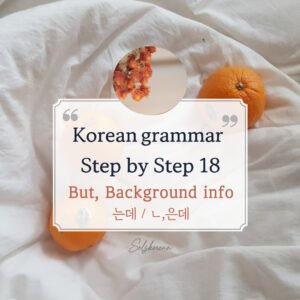To exist, have 있다(있어요) 없다(없어요)
Hello, welcome to our 4th step of your Korean journey!
Today, we’re tackling two essential verbs in the Korean language: “있다(있어요)” (to exist, to have) and “없다(없어요)” (to not exist, to not have). These verbs are fundamental in expressing possession and existence!
Let’s dive in and explore these verbs in detail.
Part 1,
Let’s grasp the concept of grammar
Verb “to have, exist” / “to not have, don’t exist” : 있다 / 없다
The verb “있다” is used to indicate that something or someone exists or is present, or that someone has something.
It’s similar to the English verbs “to have” or “to exist.”
We can conjugate 있다 to 있어요. (fairly formal), 있습니다 (extremely formal), and 있어 (informal)
| 있다 | To be present, have (original form) |
| 있습니다 | extremely formal |
| 있어요 | fairly formal, most common |
| 있어 | informal |
The verb “없다” is the negative counterpart of “있다” and is used to indicate that something or someone does not exist or is not present, or that someone does not have something.
It translates to “to not have” or “to not exist.”
We can conjugate 없다 to 없어요. (fairly formal), 없습니다 (extremely formal), and 없어 (informal)
| 없다 | To not exist, to not have (original form) |
| 없습니다 | extremely formal |
| 없어요 | fairly formal, most common |
| 없어 | informal |
The verb “있다 / 없다” is commonly used with the subject particles “이” or “가.”
The choice between “이” and “가” depends on the final consonant of the noun preceding it:
– Use “이” when the noun ends in a consonant.
– Use “가” when the noun ends in a vowel.
Let’s look at some examples:
Example 1:
There is a bag.
가방이 있어요.
가방 (bag) + 이 (particle) + 있어요 (to be present)
* This also means ‘I have a bag‘
* To say “It is a bag,” you’d say “가방이에요.” It uses the same “is” verb, but here, “이에요” is used to state that the subject (it) is identified as a bag. This is about what the subject is.
On the other hand, “가방이 있어요” uses “있다” to convey that the bag exists or is present in a certain location. This is about the presence or location of the bag.
Example 2:
There isn’t a TV.
티비가 없어요.
티비 (TV) + 가 (particle) + 없어요 (is not)
* This also means ‘I don’t have a tv‘
It’s normal and common for “이/가” particles to come together with the verb “있다/없다.”
However, you will often hear Koreans omitting these particles when speaking colloquially.
Example 3:
I have a Korean boyfriend.
(나는) 한국인 남자친구가 있어요.
나(I) + 는(subject particle)+ 한국인 남자친구 (Korean bf) + 가 (particle) + 있어요 (have)
* You don’t need to indicate “I(나는)” part if it’s clear.
* You can say “내가” as well instead of 는
Example 4:
I don’t have money.
돈이 없어요.
돈 (money) + 이 (particle) + 없어요 (don’t have)
* It also means “There isn’t money”
Let’s take a quick quiz!
1. 개 __________ [There isn’t a dog/I don’t have a dog]
(1) 가 있어요
(2) 이 있어요
(3) 가 없어요
(4) 이 없어요
2. 내 집 ___________ [I have my house]
(1) 가 있어요
(2) 이 있어요
(3) 가 없어요
(4) 이 없어요
3. 음식 _________ [There isn’t food/I don’t have food]
(1) 가 있어요
(2) 이 있어요
(3) 가 없어요
(4) 이 없어요
4. 차 __________ [There is a car/I have a car]
(1) 가 있어요
(2) 이 있어요
(3) 가 없어요
(4) 이 없어요
These are the answers:
1 – (3) 개가 없어요 (개 ends in the vowel) [There isn’t a dog/I don’t have a dog]
2 – (2) 내 집이 있어요 (집 ends in the batchim (ㅂ)) [I have my house]
3 – (4) 음식이 없어요 (음식 ends in the batchim(ㄱ)) [There isn’t food/I don’t have food]
4 – (1) 차가 있어요 (차 ends in the vowel) [There is a car/I have a car]
Good job, well done!
Now let’s learn how we can specify the location, like saying “there is a bag in my room.”
A particle Indicating location, time, and dates: 에
The particle 에 is used to indicate specific words in a sentence, particularly places or times.
When denoting a place, it functions similarly to the highlighted words in the English sentences below.
like I’m in the house.
It is in my bag.
They are at a cafe.
or I eat at 6.
I sleep at 8.
I study on Mondays.
In August, on the weekends.
To indicate ‘In, at, on’ or more propositions regarding location, time, and dates.
Most of the time we can use the particle “에” in Korean.
Then, let’s see how we can say “I’m at home(집)”
The sentence order is important; usually, 에 goes after the location, unlike in English!
To say “I am at home,” we say 나는 집에 있어요. I – home – at – am.
Let’s see more examples and get used it it!
Example 1:
A wallet is in a bag.
지갑이 가방에 있어요.
지갑 (A wallet) + 은/이 (particle) + 가방(a bag) + 에(in)+ 있어요 (is)
Example 2:
My family isn’t in Korea.
우리 가족은 한국에 없어요.
우리 가족 (My family) + 이 or 은 (particle) + 한국 (Korea) + 에(in)+ 없어요 (isn’t)
Example 3:
My cat is in my room.
내 고양이는 내 방에 있어요.
내 고양이(My cat) + 가 or 는 (particle) + 내 방 (my room) + 에(in)+ 있어요 (is)
Example 4:
My phone is not on the bed.
내 폰이 침대에 없어요.
내 폰(My phone) + 이 or 은 (particle) + 침대 (bed) + 에(on)+ 없어요 (isn’t)
We can also employ positional words to indicate the location.
The most frequently used positional words include:
앞 – in front
뒤 – behind
안 – inside
밖 – outside
위 – on, above, top
밑/아래 – under, below
옆 – next to, beside
But keep in mind the order; these positional words go directly in front of the particle “에.”
We use these words and 에 together. They are attached!
Let’s examine some examples together:
Example 1:
The cup is on the desk.
컵이 책상 위에 있어요.
컵 (The cup) + 이/은 (particle) + 책상(the desk) + 위에(on)+ 있어요 (is)
Example 2:
The dog is outside the house.
개는 집 밖에 있어요.
개 (The dog) + 가/는 (particle) + 집(the house) + 밖에(outside)+ 있어요 (is)
Example 3:
It isn’t under the bed.
침대 아래에 없어요.
침대 (the bed) + 아래에(under)+ 없어요 (isn’t)
* We don’t need to specify the subject(It) part.
Example 4:
It isn’t next to the sofa.
소파 옆에 없어요.
소파 (the sofa) + 옆에(next to)+ 없어요 (isn’t)
Good job!!!
It can be confusing, especially with the order.
However, only practice will make you more accustomed to this.
Now, let’s try to put everything together on your own.
Trust me, building sentences will enable you to think in Korean and form them much faster.
So don’t skip, and follow my advice!
Now, let’s build sentences!
1. There is a fork(포크). There isn’t a knife(나이프).
2. I don’t have a cat(고양이)
3. My friend has Thai friends (태국 친구)
4. My dad isn’t at school(학교)
5. The fork is in front of the knife. (in front- 앞)
6. My school is behind the hospital(병원)
7. My uncle(삼촌) isn’t next to me(내).
8. Your headphones(너 헤드폰) aren’t under the desk(책상). – informally
9. I’m not there(거기). I’m behind you. – informally
10. Your bag(가방) is here(여기). It isn’t on(top of) the sofa(소파). – informally
Let’s check the answers together!
1. There is a fork(포크). There isn’t a knife(나이프).
포크가 있어요. 나이프가 없어요.
* We also say “칼” for a knife!
* It also means I have a fork/ I don’t have a knife.
2. I don’t have a cat(고양이)
(나는) 고양이가 없어요.
* 나는 can be omitted.
* This also means “There isn’t a cat”
* 나 고양이 없어! (very casually) – when talking to friends
저는 고양이가 없습니다 (very polite) – when talking to a boss
3. My friend has Thai friends (태국 친구)
내 친구는 태국 친구가 있어요.
* You can use 가 instead of 는
* 내 친구는 태국 친구가 있어 (Very casual)
제 친구는 태국 친구가 있습니다 (Very formal)
4. My dad isn’t at school(학교)
우리 아빠는 학교에 없어요.
* You can use 가 instead of 는
* Don’t forget to use “에” for “at”.
5. The fork is in front of the knife. (in front- 앞)
포크는 나이프 앞에 있어요
*포크 (The fork) + 가/는 (particle) + 나이프(the knife) + 앞에(in front)+ 있어요 (is)
6. My school is behind the hospital(병원)
우리 학교는 병원 뒤에 있어요
* you can use 내 in stead of 우리. but 우리 학교 is more common than 내 학교
* 우리 학교 (My school) + 가/는 (particle) + 병원(the hospital) + 뒤에(behind)+ 있어요 (is)
7. My uncle(삼촌) isn’t next to me(내).
우리 삼촌은 내 옆에 없어요
* you can use 내 in stead of 우리. but 우리 삼촌 is more common than 내 삼촌.
Regarding relatives, we tend to use 우리 more than 내 as well.
* 우리 삼촌 (My uncle) + 은/이 (particle) + 내(me) + 옆에(next to)+ 없어요 (isn’t)
8. Your headphones(헤드폰) aren’t under the desk(책상).
너 헤드폰은 책상 아래에 없어 (informal)
* 너 헤드폰 (Your headphones) + 은/이 (particle) + 책상(the desk) + 아래에(under)+ 없어요 (aren’t)
* 너(your) is informal. It sound natural to match the ending conjugation to informally as well.
* 당신 헤드폰은 책상 아래에 없어요(fairly formal)
9. I’m not there(거기). I’m behind you.
(나는) 거기에 없어. 너 뒤에 있어. (informal)
* 거기(there) + 에 (particle) + 없어 (am not) / 너(you) + 뒤에(behind)+ 있어 (is)
* We put ‘에’ after ‘거기(there)’as well!, but to be causal, you can omit ‘에’
* 저는/나는 거기에 없어요. 당신 뒤에 있어요. (fairly formal)
* Don’t need to indicate the subject ‘I’, since it’s clear.
10. Your bag(가방) is here(여기). It isn’t on(top of) the sofa(소파).
너 가방 여기에 있어. 소파위에 없어. (informal)
* 너 가방(Your bag) + 여기에(here) + 있어 (is) / 소파(sofa) + 위에(on, top)+ 없어 (isn’t)
* We put ‘에’ after ‘여기(here)’as well!, but to be causal, you can omit ‘에’
* 당신 가방은 여기에 있어요. 소파 위에 없어요. (fairly formal)
* I omitted the 은/이 subject particle, to sound casually, it’s common to omit the them.






